Home / Blog / Details
SEO
Grow Your Ecommerce Store with This Small Business SEO Guide
SEO
I've seen it happen more times than I can count. An ecommerce business owner, frustrated with rising Facebook and Google ad costs, decides to finally invest in SEO. They pour money into it for months, only to see… nothing. Crickets.
The hard truth is, most small business SEO fails. Not because SEO is a scam, but because the strategy is broken from the very start. From my experience, they chase the wrong keywords, ignore the technical gremlins hiding on their website, and, understandably, give up way too soon.
Why SEO Is No Longer Optional
For pretty much every ecommerce business I’ve worked with, the conversation starts the same. They've dabbled in Facebook Ads or thrown money at Google Ads, but the costs keep climbing and profits get squeezed. They know they should be doing SEO, but it just feels like this big, mysterious black box.
Here's the thing: SEO isn't just an "option" anymore. It's the foundation of sustainable, long-term growth for your store.
I’ve diagnosed hundreds of Shopify and WordPress sites over the years, and the pitfalls are surprisingly consistent. Business owners either get obsessed with vanity metrics—like ranking for a keyword that nobody actually searches for—or they completely overlook the technical basics that stop Google from even understanding what their site is about. This is especially true when it comes to things like setting up Google Tag Manager containers properly or ensuring the Meta Conversion API is installed correctly for accurate tracking.
This isn't about some abstract theory. It's about building a real, tangible asset for your business that brings in traffic and sales while you sleep.
The Disconnect Between Investment and Knowledge
The problem often boils down to a massive knowledge gap. The Australian SEO industry is now valued at a whopping $1.5 billion, and the average small business is investing around $1,350 per month into it.
Despite that huge spend, a 2023 study found that 64% of small business owners still don't really grasp how SEO works or the massive impact it can have.
This is the cycle of failure I see playing out constantly: a significant investment is made, but it's channelled into the wrong things, which inevitably leads to poor results and the belief that "SEO doesn't work."
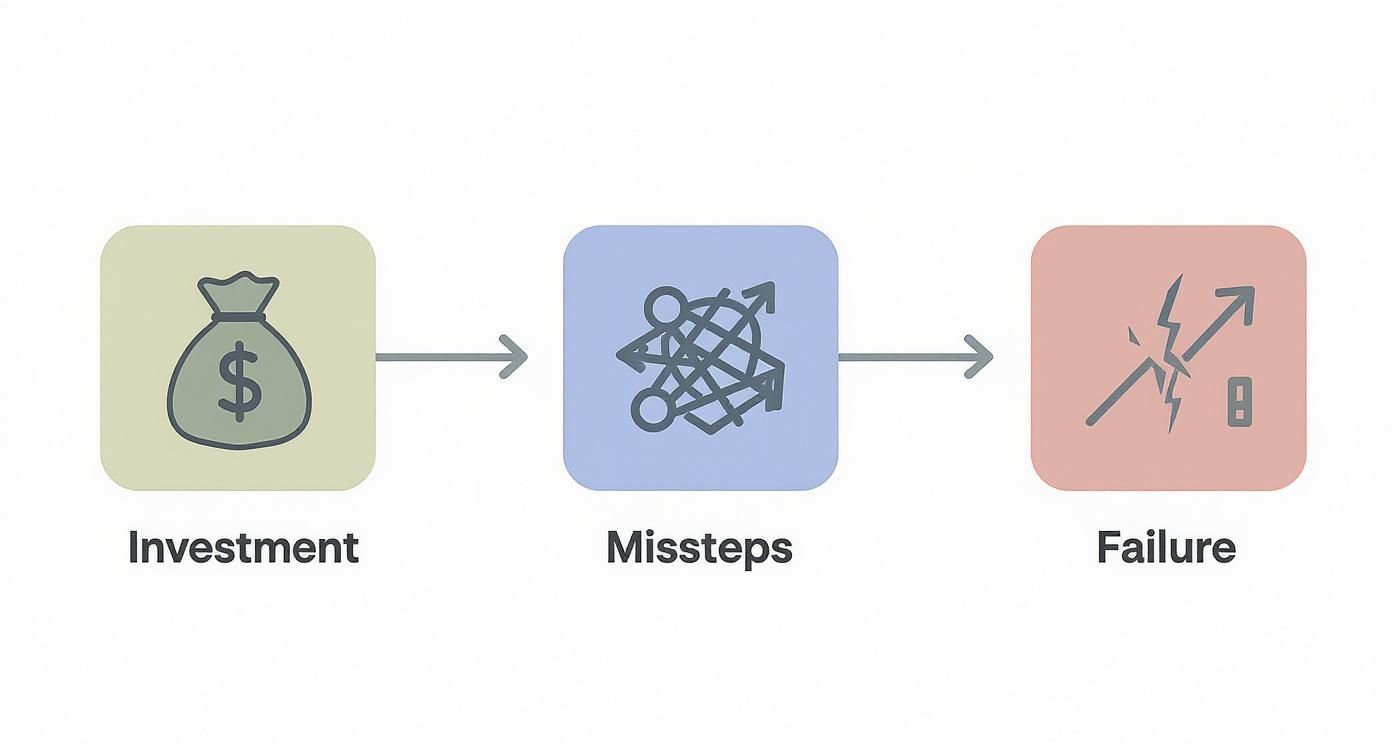
Breaking this cycle means ditching the guesswork and following a clear, actionable plan.
My core philosophy is simple: Good small business SEO focuses on tangible results that actually impact your bottom line—not just getting a gold star from some ranking tool. It’s about attracting the right customers who are ready to buy what you're selling.
I've been in this game a long time, and I've heard every myth in the book. It’s time to separate the fluff from what actually gets results on the ground for ecommerce stores.
Common SEO Myths vs My On-The-Ground Reality
| Common Myth | The Reality from My Experience |
|---|---|
| "SEO is all about getting to #1 on Google." | Ranking is great, but ranking for the right keywords that lead to sales is what matters. I'd rather be #3 for a high-intent keyword than #1 for a vanity term that brings zero revenue. |
| "You just need to publish lots of blog posts." | More content isn't always better. A few strategic, high-quality pieces that answer real customer questions will outperform a hundred generic, low-effort articles every time. |
| "SEO is a one-time setup." | SEO is never "done." It’s an ongoing process of optimising, creating, and adapting. Your competitors aren't standing still, and neither should you. |
| "Link building is dead." | Absolutely not. Quality backlinks are still one of the strongest signals to Google that your site is authoritative and trustworthy. The tactics have changed, but the principle remains. |
The takeaway here is that chasing shortcuts or outdated advice is a recipe for wasted money. A smart, modern approach is what wins.
Adopting a Smarter Approach
To make sure your efforts don't fall into the same traps, you need to start with the right framework. This means really understanding your customers, fixing your website's technical foundation, and creating content that serves a genuine purpose.
As technology evolves, so does SEO. To ensure your efforts pay off, it’s crucial to adopt a modern AI SEO strategy that integrates new tools for better insights and faster execution.
Throughout this guide, I'll lay out the practical groundwork for a strategy that actually works. We'll cut through the noise and build a playbook you can follow, step-by-step, focusing on the key areas that drive real growth for ecommerce businesses.
Alpha Omega Digital is a marketing agency based in Melbourne, Australia but also services clients from Sydney, Brisbane, Newcastle, Perth, Adelaide, Darwin and Hobart. Have a project in mind? Contact us.
Winning Your Local Area First
Before you even think about ranking nationally, you have to win your own neighbourhood. It's a mistake I see all the time: ecommerce businesses get obsessed with competing against the giants across the country, while completely ignoring the people searching for their products right in their own backyard.
This is the ultimate equaliser. It’s your first major step to getting visible where it matters most.
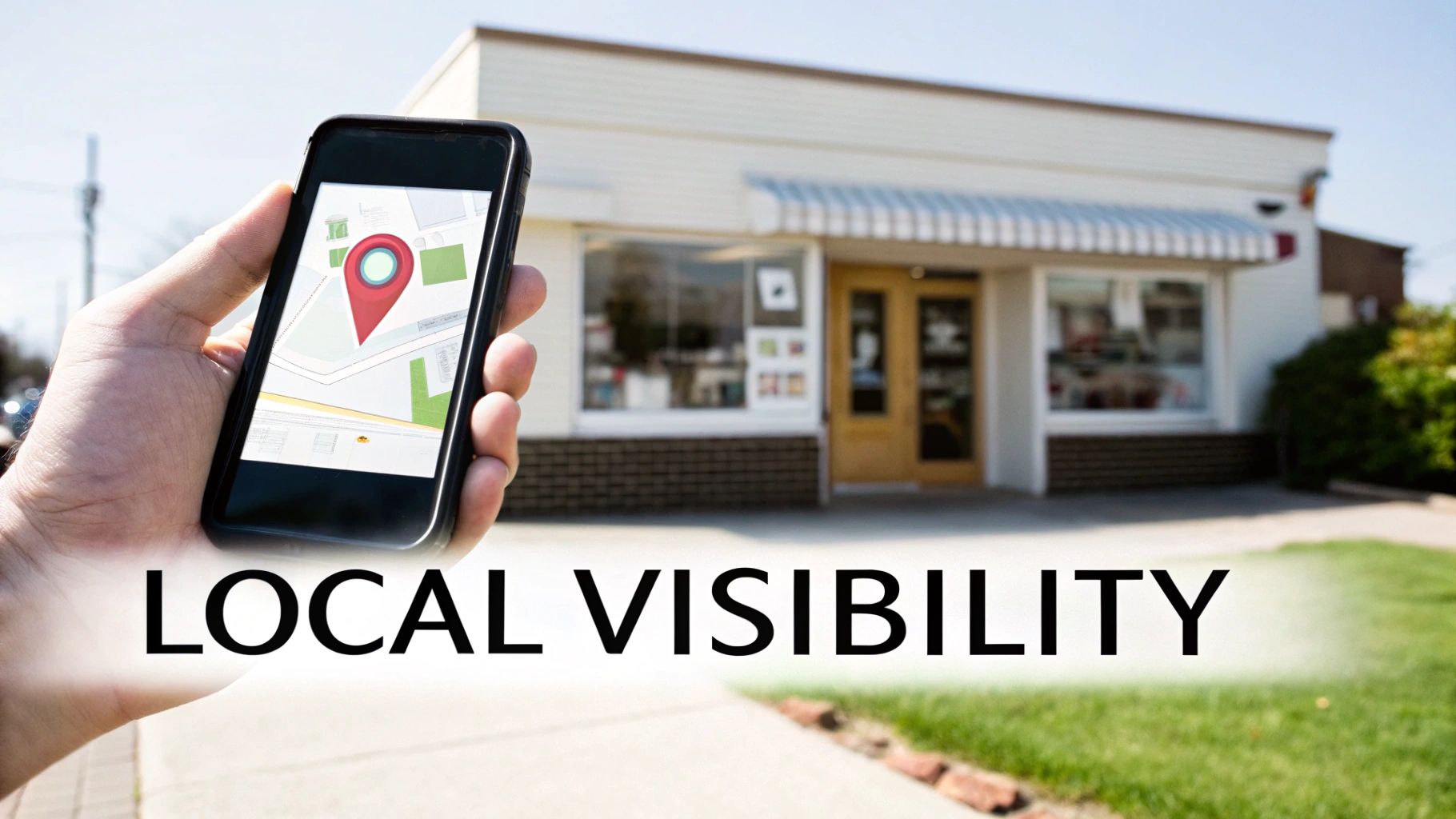
Think about it: if someone in Melbourne is looking for handmade leather goods, they’re far more likely to buy from a local artisan they can visit or get fast delivery from. To truly succeed, small businesses have to dominate their local area first, and that means getting serious about Local SEO: Boosting Your Visibility in Regional Searches.
This is where your Google Business Profile (GBP) becomes your most powerful tool. It’s not just a listing; it's your digital storefront on Google Search and Maps. I tell all my clients that an unoptimised GBP is like having a shop with no sign on the door. You have to treat it with care.
Making Your Google Business Profile Pop
Setting up your GBP is the easy part. Making it actually work for you? That takes a bit more attention to detail.
Here’s what I focus on with every client to make their profile stand out:
- Complete Every Single Section: Don't skip anything. Fill out your services, products, accessibility options, and business hours meticulously. The more information you give Google, the more confidently it can recommend you.
- Use High-Quality Photos and Videos: Get some clear, professional photos of your products, your workspace, and even your team. A short video tour can be incredibly effective. Keep adding new photos regularly—it shows Google your profile is active and loved.
- Write a Keyword-Rich Description: Your business description is prime real estate. Weave in your main services and location naturally. Instead of "We sell candles," try something like "Hand-poured soy wax candles made in Melbourne, offering local delivery across Sydney Rd."
- Get Active with Google Posts: This is basically a mini-blog inside your profile. Use it to announce new products, share special offers, or link to your latest blog post. It’s a direct way to communicate with potential customers and proves to Google you’re engaged.
The Power of Local Keywords and Reviews
Once your GBP is dialled in, the next move is to thread local signals throughout your actual website. This means finding and using location-specific keywords. I’m not talking about just stuffing "Melbourne" everywhere, either. It has to be strategic.
For a client selling custom furniture, we targeted terms like "bespoke timber desks Melbourne" and "reclaimed wood dining table Fitzroy" on their product and category pages. This tells Google exactly who and where their products are for.
At the same time, you need a system for generating genuine reviews. Positive reviews are a massive trust signal for both customers and Google. Don't be shy about asking satisfied customers to leave one. A simple follow-up email after a purchase with a direct link to your GBP review page works wonders.
A consistent flow of positive reviews is one of the strongest local ranking factors. It validates your business and creates a feedback loop that attracts more local customers. Always respond to every review—good and bad—to show you're listening.
Capturing the "Near Me" Goldmine
The rise of mobile has made local search incredibly powerful. You might wonder how important this is for an ecommerce business. The data is clear: in Australia, 46% of all Google searches have local intent. For mobile users, this is even more critical, as 78% of local mobile searches lead to a store visit within 24 hours.
The phrase 'near me' has grown 500% since 2015, which shows just how location-centric we've become.
Even if you're purely online, if you offer local delivery or click-and-collect, you can capture this traffic. By optimising for "near me" searches, you put your business directly in front of highly motivated buyers at the exact moment they're ready to make a purchase. This is your foundation for sustainable growth.
Alpha Omega Digital is a marketing agency based in Melbourne, Australia but also services clients from Sydney, Brisbane, Newcastle, Perth, Adelaide, Darwin and Hobart. Have a project in mind? Contact us.
Practical On-Page SEO for Ecommerce Platforms
Alright, we’ve nailed the local game plan. Now it’s time to zoom in on your actual website. This is where the real magic happens, whether you're running on Shopify or a WordPress site with Gutenberg. On-page SEO is all about telling Google exactly what your pages are about, and making them compelling enough for a real person to stick around.
I’m going to walk you through the core elements I optimise for every ecommerce client, focusing on the pages that actually make you money: your product and category pages.
Mastering Titles and Descriptions
Your meta title and description are your digital billboard on Google's search results page. They're often the very first impression a potential customer gets of your brand, so getting them right is non-negotiable.
It's not just about stuffing keywords in; it's about crafting a message that earns the click. Think of your title as the headline and your description as the sub-headline. They need to work together to be persuasive.
For a client selling reusable coffee cups in Melbourne, we changed their product page title from a bland "12oz Reusable Cup" to something far more compelling: "12oz Reusable Coffee Cup Melbourne | Leakproof & Barista-Friendly".
The "before" was purely descriptive. The "after" immediately answers key questions and includes a location modifier—a seriously powerful signal for local search.
We gave their meta description a similar makeover.
- Before: "A great reusable cup for your daily coffee."
- After: "Tired of spills? Our 12oz reusable coffee cup is 100% leakproof. Made in Melbourne from recycled materials. Free shipping over $50. Shop now & save!"
The new version highlights key benefits (leakproof), mentions a unique selling point (recycled materials), adds a juicy offer (free shipping), and ends with a clear call to action. This one small change dramatically increased their click-through rate.
Structuring Content for Humans and Bots
Once someone lands on your page, the structure of your content determines whether they stick around. This is where headings (H1, H2, H3) come in. They create a clear hierarchy that makes your content easy for humans to scan and simple for Google to understand.
Here’s the simple structure I follow:
- H1: Your main page title. There should only be one H1 per page. For a product, this is usually the product name.
- H2s: Use these for major sections. On a product page, this could be "Product Description," "Key Features," and "Customer Reviews."
- H3s: Use these to break down the H2 sections. Under "Key Features," you might have H3s for "Material," "Dimensions," and "Care Instructions."
This structure isn't just for show. It helps Google's crawlers quickly grasp the main topics of your page, which directly impacts how you rank.
A well-structured page with clear headings keeps users engaged longer. This increased "dwell time" is a positive signal to Google, telling it that your page is a high-quality, relevant result for a searcher's query.
Optimising Your Product Images
For ecommerce, your images are your salespeople. But huge, unoptimised images can kill your page speed, and slow pages are a major ranking killer. Every image you upload needs to be optimised for both speed and search.
Here’s my quick checklist:
- Compress Your Images: Before you upload anything, use a tool like TinyPNG or ImageOptim to shrink the file size without sacrificing much quality.
- Use Descriptive File Names: Don't upload
IMG_4567.jpg. Change it toreusable-coffee-cup-melbourne-black.jpg. This gives Google another clue about what the image contains. - Write Good Alt Text: Alt text is what appears if an image can't load, and it's what screen readers use for visually impaired users. It’s also crucial for SEO. Your alt text should be a concise, accurate description of the image, like "A black 12oz reusable coffee cup with a leakproof lid."
Going Beyond the Template
Sometimes, standard Shopify or WordPress themes just don't cut it. For clients who need to stand out, we often turn to custom development. My real passion lies in Shopify and WordPress development and design. Building custom Gutenberg blocks in WordPress or custom sections and apps in Shopify (using Shopify CLI) allows us to create unique, SEO-friendly page layouts that break the mould. The Shopify API is an incredible tool for this.
For example, we built a custom "Ingredients" block for a skincare brand. This allowed them to create a visually engaging section with icons and dropdowns for each ingredient, providing valuable content for users and rich, crawlable text for Google. This is the kind of detail that elevates a store from good to great.
Alpha Omega Digital is a marketing agency based in Melbourne, Australia but also services clients from Sydney, Brisbane, Newcastle, Perth, Adelaide, Darwin and Hobart. Have a project in mind? Contact us.
Technical SEO You Can Actually Manage
Technical SEO. That phrase is enough to make most business owners shudder. It sounds complicated, expensive, and like something you definitely need a developer on speed dial for. But I promise you, there are a handful of foundational fixes you can manage yourself that will make a massive difference to how Google sees your site.
Let’s get our hands dirty with the technical stuff you can actually control.
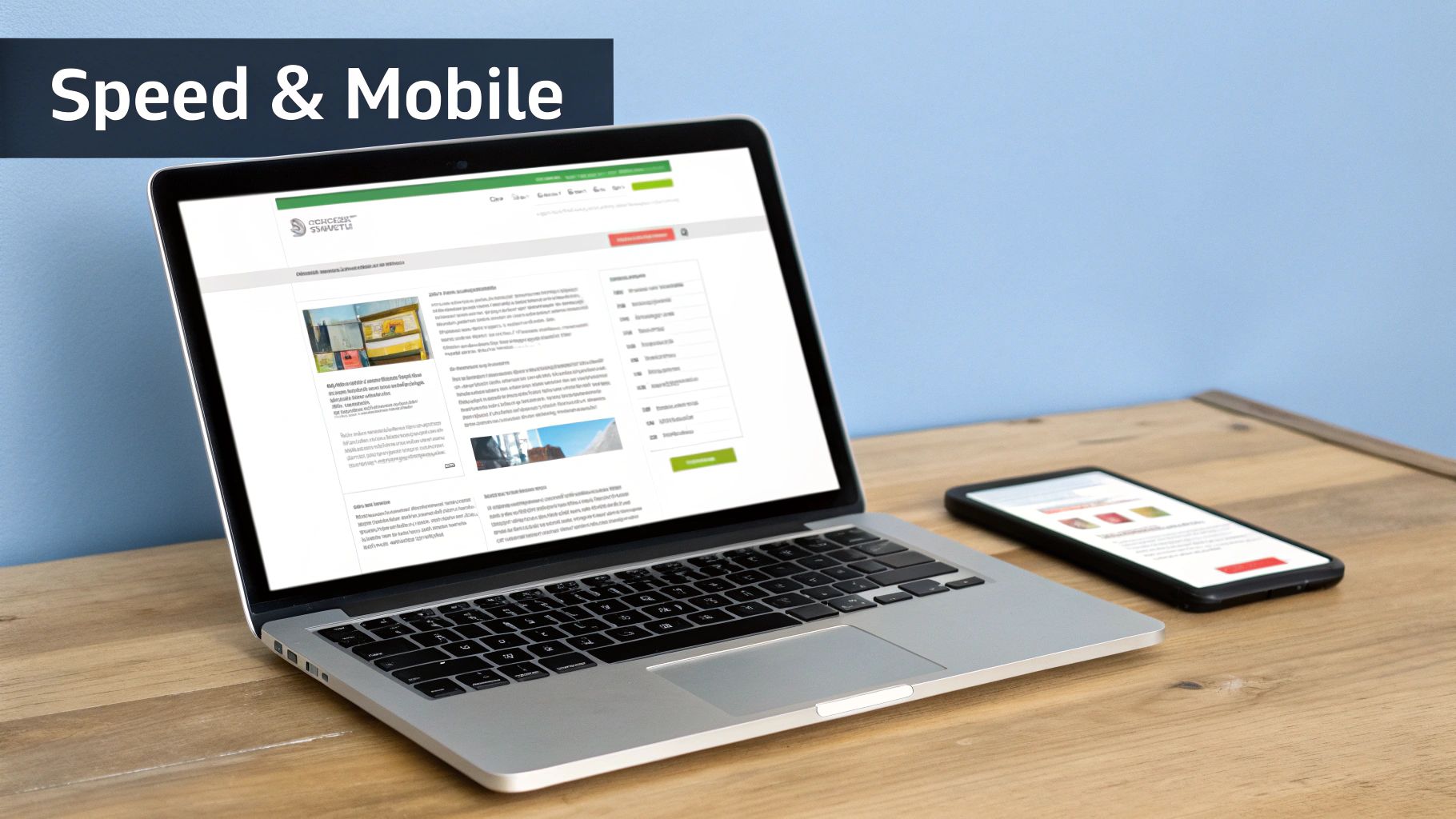
Crushing Slow Site Speed
Site speed isn't just a "nice to have"—it's a massive ranking factor and a conversion killer. For an e-commerce store, a one-second delay in page load time can lead to a 7% drop in conversions. That’s real money you’re leaving on the table.
Before you can fix anything, you need to know where you stand. I always start by running a site through these two tools:
- Google PageSpeed Insights: This is Google’s own tool, so its recommendations carry a lot of weight. It gives you separate scores for mobile and desktop and a prioritised list of fixes.
- GTmetrix: This one provides a more detailed waterfall chart, showing you exactly which elements are loading and how long they're taking. It's brilliant for pinpointing specific problem files.
From my experience working with hundreds of small business sites, the speed killers are almost always the same.
On Shopify, watch out for:
- Too Many Apps: Every app you install adds code to your site, which can slow things down. Be ruthless and uninstall any apps you aren't actively using.
- Huge, Unoptimised Images: Just like we discussed in the on-page section, this is the number one culprit. Compress every single product and banner image.
On WordPress, common issues include:
- Bloated Themes and Page Builders: Some themes are packed with features you’ll never use, all of which add weight. A lightweight theme paired with the native Gutenberg editor is almost always faster.
- Slow Hosting: Cheap, shared hosting can't handle traffic spikes and will cripple your site's performance. Investing in good quality hosting from day one is non-negotiable.
Getting Your Tracking Foundations Right
You can't improve what you don't measure. Before you go any further, you need a solid system for tracking what people do on your site. This is where Google Tag Manager (GTM) comes in.
Think of GTM as a toolbox. Instead of asking a developer to hard-code every single tracking script (like Google Analytics, Meta Pixel, etc.) onto your site, you just install the GTM container once. From there, you can add, remove, and manage all your other tracking "tags" from inside the GTM interface, no code needed.
Setting up a basic GTM container is a crucial first step. I also spend a lot of time ensuring my clients have their Meta Conversion API installation sorted for accurate Facebook and Instagram ad tracking. It’s fundamental for everything from running effective Google Shopping Ads to understanding the true ROI of your marketing spend.
Cleaning Up Digital Mess
As your store grows, you'll add and remove products, change URLs, and run promotions. This can create a lot of digital clutter that confuses search engines, mainly in the form of duplicate content and broken links.
Here are two key concepts to get your head around:
- Redirects (301s): If you delete a product or change its URL, you can't just leave a dead end. A 301 redirect is a permanent signpost that tells both users and search engines, "Hey, this page has moved. The new one is over here." This passes the SEO value from the old URL to the new one and stops people from landing on a dreaded "404 Not Found" page.
- Canonical Tags: Sometimes you have multiple URLs showing the same (or very similar) content. This is common in e-commerce with product variants or filtered collection pages. A canonical tag is a small piece of code that tells Google, "Of all these similar pages, this one is the master version. Please index this one and ignore the others." It's a simple fix that prevents duplicate content issues from hurting your rankings.
Finally, you need an XML sitemap. This is simply a list of all the important pages on your site that you want Google to crawl and index. Both Shopify and WordPress (with an SEO plugin like Yoast) generate one for you automatically. Your only job is to make sure it's submitted to Google Search Console, which is like giving Google a direct map to all your best content.
These technical elements aren't glamorous, but they are the bedrock of good small business SEO. Getting them right ensures that all your hard work on content and on-page optimisation can actually be seen and understood by search engines.
Alpha Omega Digital is a marketing agency based in Melbourne, Australia but also services clients from Sydney, Brisbane, Newcastle, Perth, Adelaide, Darwin and Hobart. Have a project in mind? Contact us.
Creating Content That Actually Sells Your Products
Content is supposed to be the engine of your SEO strategy, but I’ve seen so many small businesses spin their wheels creating blog posts that go absolutely nowhere. They write about generic topics, get a trickle of traffic, and then wonder why nobody is buying.
The secret? Stop thinking like a blogger and start thinking like a problem-solver for your customers. Your content needs to directly support your products and gently guide people towards a purchase.
This means shifting your focus from random articles to creating strategic assets that answer your customers' biggest questions. Every single piece of content should have a clear commercial purpose.
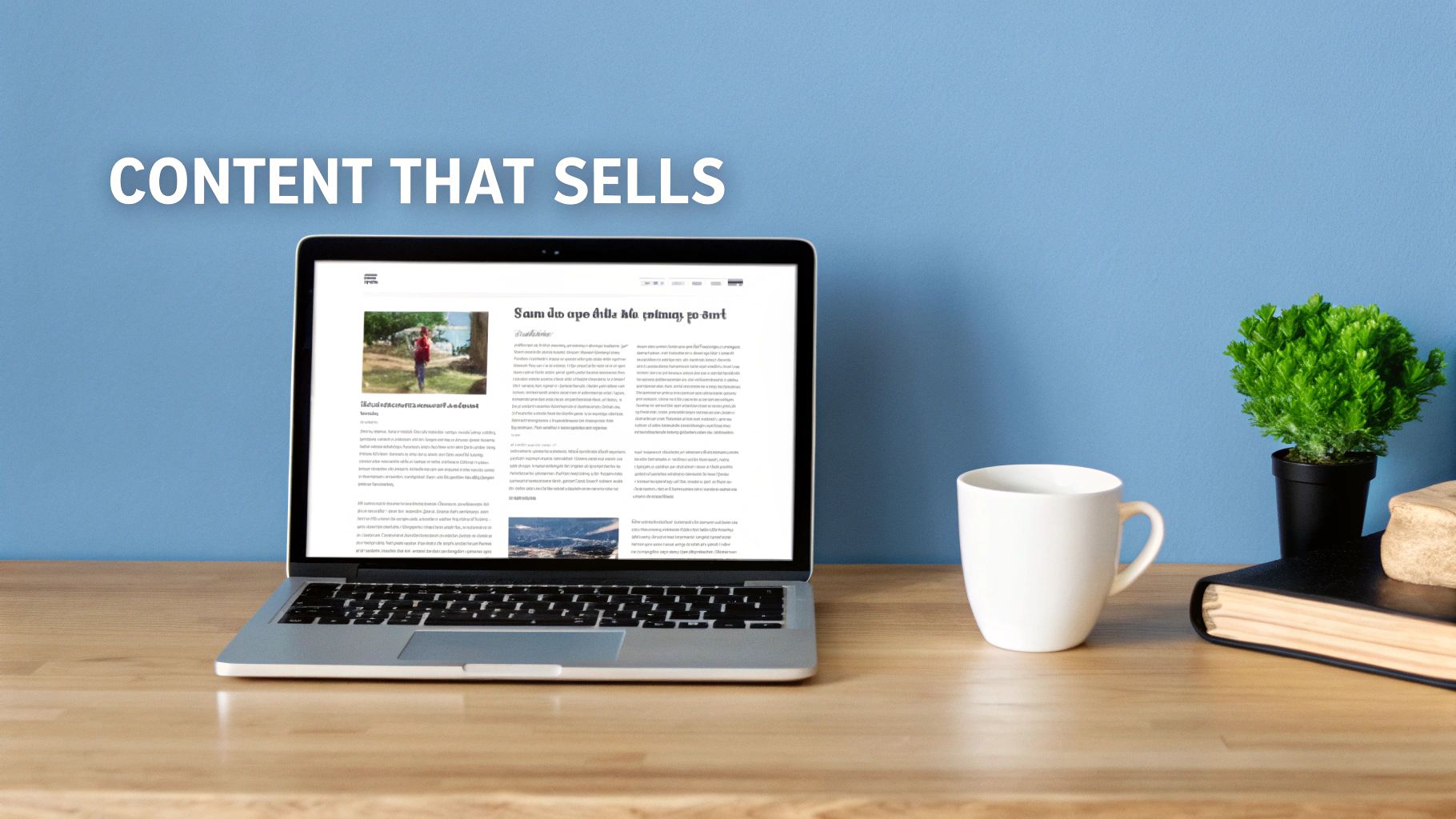
This approach turns your blog from a simple cost centre into a powerful customer acquisition channel that works for you 24/7.
Brainstorming Content That Converts
Forget about trying to guess what people want to read. The best content ideas come directly from your customers and your products. The goal is to create content that intercepts a customer at the exact moment they’re trying to make a decision.
Here are a few content types I build for my e-commerce clients that consistently drive real revenue:
- Detailed Buying Guides: If you sell hiking boots, a guide on "How to Choose the Right Hiking Boots for Victorian Trails" is invaluable. It positions you as an expert and lets you naturally feature your own products as the perfect solution.
- Product Comparison Articles: Are customers often stuck choosing between two of your popular products? Write an article comparing them head-to-head. A post like "Product A vs. Product B: Which One is Right for You?" helps hesitant buyers make a confident decision.
- In-Depth "How-To" Tutorials: Show your products in action. If you sell high-quality kitchen knives, a video and blog post on "How to Perfectly Dice an Onion" not only provides genuine value but also showcases the superiority of your knife.
Planning for Consistency with a Content Calendar
Great ideas are useless without execution. One of the biggest reasons I see content marketing fail is a lack of consistency. Publishing three articles one month and then nothing for the next six sends a terrible signal to both Google and your audience.
You don't need a complicated project management tool to get this right. A simple spreadsheet is all it takes to stay on track.
Consistency is the cornerstone of marketing your business. A simple content calendar that you actually stick to is far more effective than an ambitious, complex one that gets abandoned after a few weeks. Start small, stay consistent, and build from there.
Here’s a basic structure you can use for your content calendar:
| Publish Date | Topic/Title | Target Keyword | CTA (Call to Action) | Status |
|---|---|---|---|---|
| 01/08 | How to Choose Hiking Boots | hiking boots for victorian trails | Shop our Trailblazer Boots | Published |
| 15/08 | Boot A vs. Boot B Comparison | boot a vs boot b | Compare Our Hiking Boots | Writing |
| 01/09 | Waterproofing Your Boots | how to waterproof hiking boots | Buy Our Waterproofing Spray | Scheduled |
This simple framework keeps you organised and ensures every piece of content has a clear purpose and a path to conversion.
Promoting Your Content Beyond Publishing
Hitting the "publish" button is only about half the battle. You can’t just expect people to find your amazing content on their own. You need to actively promote it to get the initial traction that helps it rank over time.
Think about where your audience spends their time online. If you have an email list, share your new post with them. Post it on your relevant social media channels, like an Instagram Shop or Facebook Shop.
If it’s a really high-value piece of content, you might even consider running a small Facebook Ads campaign to get it in front of a highly targeted audience. I run a Facebook Ads agency, and a key part of our creative testing process is promoting valuable content to cold audiences to build trust and authority before asking for the sale. This is how you measure success with Facebook Ads over the long term; don't quit too early just because a content piece didn't lead to a direct sale in the first 7 days.
This initial promotional push helps get eyes on your content, which can lead to social shares and backlinks—all crucial signals that tell Google this is a valuable piece of content worth ranking. This is how you transform your blog into a reliable sales-generating machine.
Alpha Omega Digital is a marketing agency based in Melbourne, Australia but also services clients from Sydney, Brisbane, Newcastle, Perth, Adelaide, Darwin and Hobart. Have a project in mind? Contact us.
Time to Build Authority and Measure What Matters
You’ve put in the hard yards on-site, but now it’s time for the part that can feel a bit overwhelming for a lot of business owners: building authority. This is where link building comes in, and I promise it’s not as scary as it sounds. Forget what you’ve heard about complex, spammy tactics. For most small and e-commerce businesses, the best approach is simple, local, and built on genuine relationships.
I always start with the easy wins—the low-hanging fruit. Securing listings in reputable local online directories is a no-brainer. These send clear local signals to Google and build a foundational layer of trust.
From there, I look for natural partnership opportunities. Think about businesses that complement what you do. If you sell artisanal cheese, team up with a local winery for a blog post. If you’re a boutique gym, partner with a nearby health food cafe. A joint giveaway or a featured article is a fantastic way to earn a relevant, valuable link.
Focusing on Links You Earn, Not Just Build
Honestly, the most powerful links are the ones you don’t even have to ask for. These are the ones that come naturally when you create something genuinely useful.
Remember those buying guides and tutorials we talked about earlier? That’s the kind of content that earns links. When you create a resource that’s truly helpful, other websites and bloggers in your niche will link to it because it makes them look good, too. This is how you build a strong, sustainable backlink profile over the long haul.
A solid local presence goes way beyond just links, though. I saw a case study on a small business that went all-in on their Google Business Profile. They fully optimised it, gathered 25 new reviews, and focused on local keywords.
The result? They shot into the top 3 Google Maps results within six weeks, bringing in an extra 15-20 customers every single day. It just proves the immense value of local authority. You can discover more about Australian local SEO statistics to see the full picture.
Measuring What Actually Moves the Needle
Alright, let's tie this all together. All this effort is completely wasted if you can't tell whether it's actually working. I always encourage my clients to sidestep the sea of overwhelming data and just focus on a few key metrics in Google Analytics and Google Search Console.
Don't get distracted by vanity metrics. The only numbers that matter are the ones that tell you if your SEO is driving traffic that leads to sales. This is how you prove your return on investment.
Here’s what I keep a close eye on every week:
- Organic Traffic: Is the number of visitors coming from search engines trending upwards? Simple as that.
- Keyword Rankings: Are you climbing the ladder for your most important, money-making keywords?
- Organic Conversion Rate: Are the people finding you through search actually buying your products?
By tracking these core metrics, you can make smart, data-backed decisions about where to put your energy next. It ensures your small business SEO strategy is always driving real, measurable growth, not just ticking boxes.
Alpha Omega Digital is a marketing agency based in Melbourne, Australia but also services clients from Sydney, Brisbane, Newcastle, Perth, Adelaide, Darwin and Hobart. Have a project in mind? Contact us.
Answering Your Small Business SEO Questions
Over the years, I've had countless coffees with ecommerce owners, and the same handful of questions about SEO and Google Ads always seem to pop up. Let's tackle them head-on with some straight answers, based on what I've seen work for businesses across Australia.
How Much Should a Small Ecommerce Business Spend on Google Ads?
This is a common question, and the answer is "it depends". A good starting point for a small ecommerce business is often around $50 to $100 per day. The key is to start small, gather data, and scale what's working. If you're running a dropshipping business, your Google Shopping ads strategy will be different from a brand with its own inventory. When I'm building a beginner's guide to Google Shopping Ads for clients, I always stress the importance of understanding campaign priority settings. Many times I've had clients complain their Google Shopping ads are not spending budget, and it often comes down to a simple priority or bidding issue. The debate of PMAX vs Google Shopping ads is also a hot topic, but for beginners, standard shopping campaigns offer more control.
How Long Does SEO Take to Actually Work?
This is the big one. Patience and consistency are everything in SEO. Generally, you can expect to see the first positive signs—like better rankings for a few keywords and a bump in organic traffic—within 3 to 6 months.
But for significant, business-changing results? You're often looking at 6 to 12 months of consistent effort. It really is a marathon, not a sprint. If anyone promises you page one rankings in a few weeks, they're not being straight with you.
Can I Do SEO Myself or Do I Need to Hire Someone?
You can absolutely get started with DIY SEO, and this guide is built to help you do just that.
Focusing on the fundamentals like getting your local SEO sorted, cleaning up your on-page optimisation, and creating genuinely helpful content can get you surprisingly far. As your business grows, or if you find yourself in a really competitive market, partnering with an agency can seriously accelerate your growth and free you up to do what you do best—run your business.
Alpha Omega Digital is a marketing agency based in Melbourne, Australia but also services clients from Sydney, Brisbane, Newcastle, Perth, Adelaide, Darwin and Hobart. Have a project in mind? Contact us.
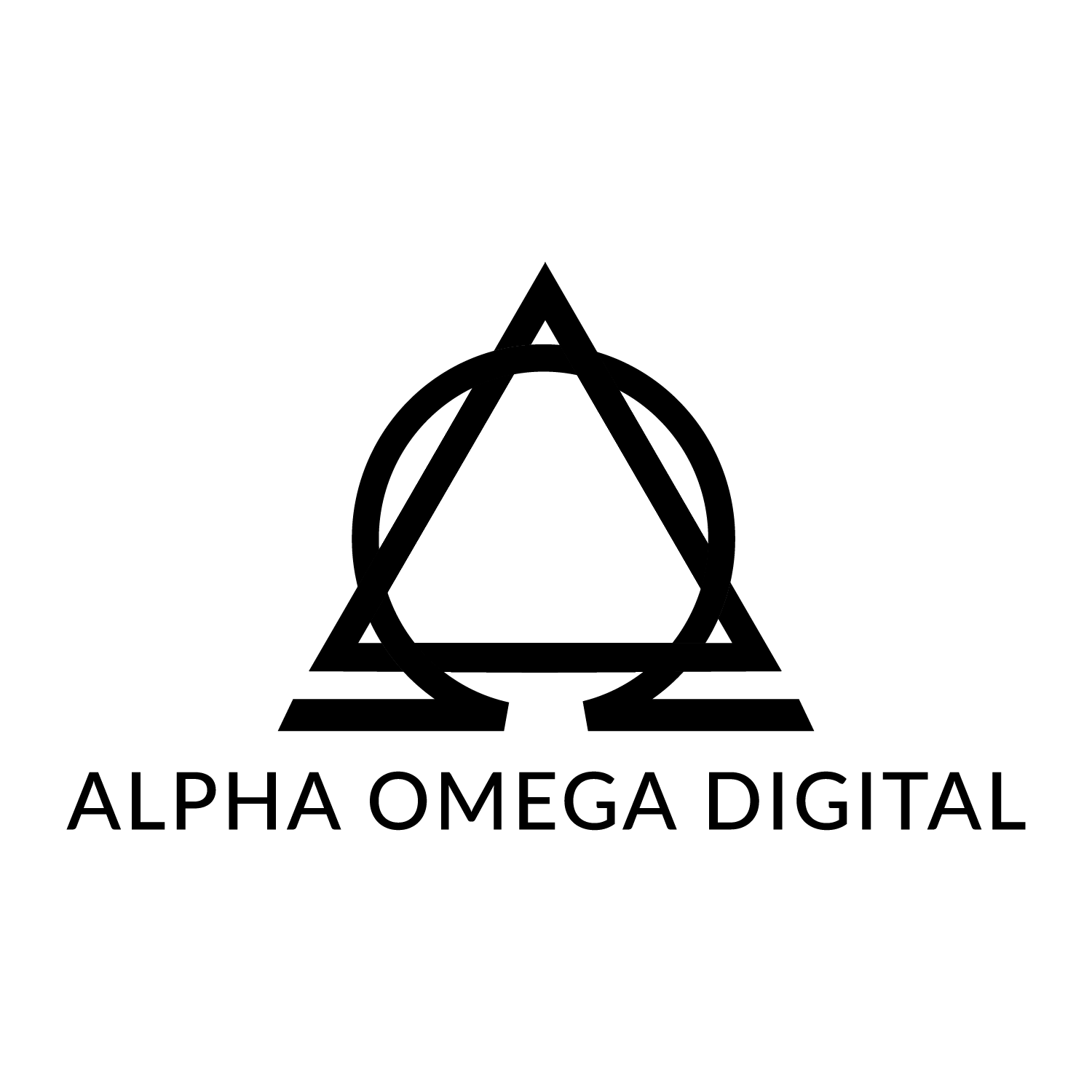
Your Comment
Your email address will not be published. Required fields are marked *